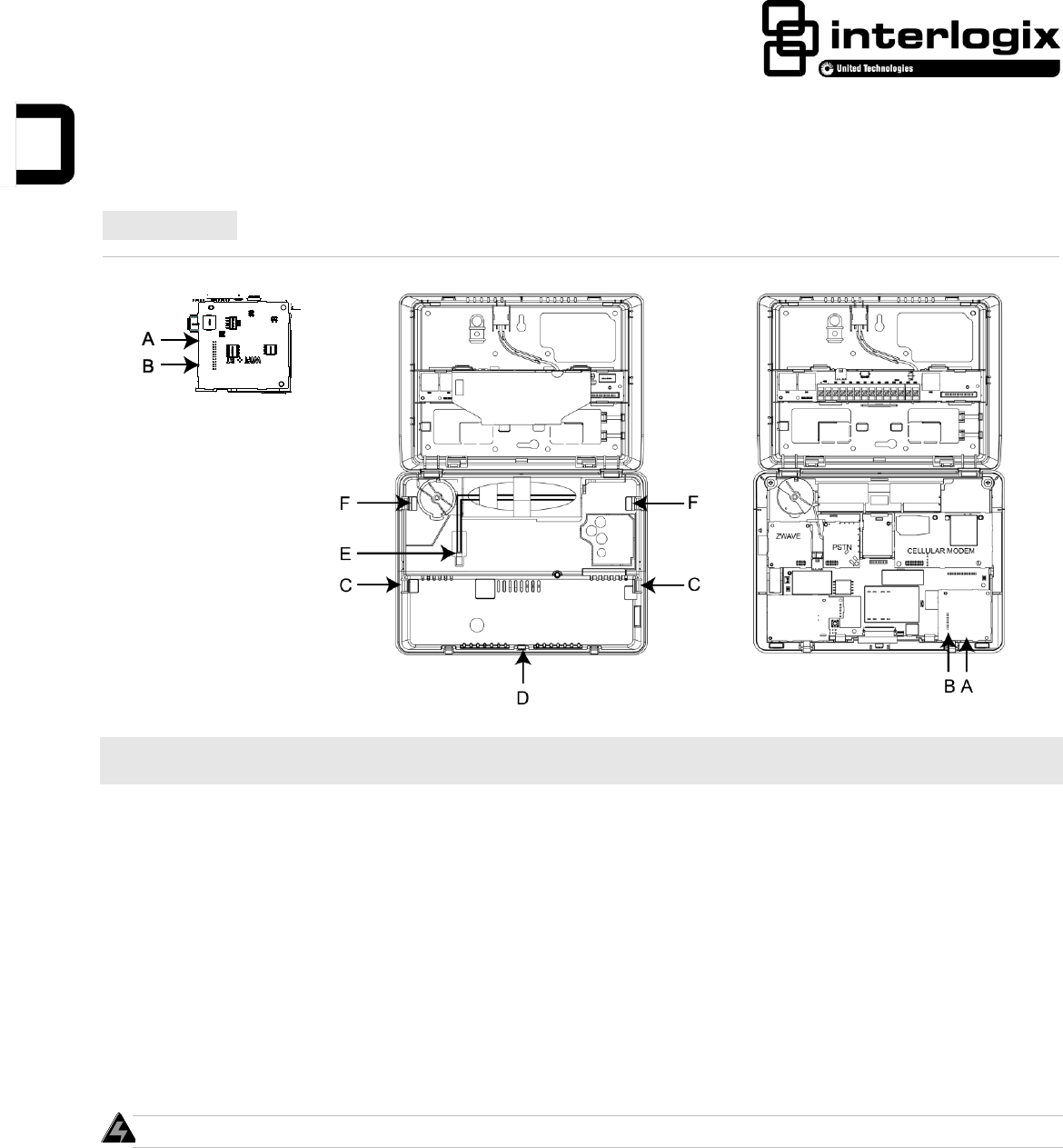UTC Fire and Security Americas 958-BTWI AVO-BTWIFI User Manual
UTC Fire & Security Americas Corporation, Inc. AVO-BTWIFI
user manual

P/N 466-4408 • REV C • 23APR15 1 / 6
AdvisorOne Bluetooth® Wi-Fi® Installation Sheet
EN
CNF
ES
PR
1. Bluetooth Wi-Fi Module
2. AdvisorOne Panel (With Covers Installed)
3. AdvisorOne Panel (With Covers Removed)
English: Installation Sheet
Description
The Advisor™One self-contained lifestyle management and security system detects situations and provides control and information
to home and small business owners (P/N AVO-1037).
This document provides instructions on installing and programming the AdvisorOne Bluetooth Wi-Fi module (P/N AVO-BTWIFI) for
use with the AdvisorOne panel.
The AdvisorOne Bluetooth Wi-Fi module extends the capability of interfacing with the AdvisorOne system. The module’s Wi-Fi
capability enables wireless Ethernet connections to a router and/or provides wireless Ethernet connection to touchscreens and IP
cameras. The module’s Bluetooth capability enables mobile device access and control.
Preparation and Installation
Preparing to Install the Bluetooth Wi-Fi Module
WARNING: Use caution when installing or removing the power supply to an outlet with a metal cover.
1. Depending on the situation, it may be necessary to contact the central monitoring station before starting the installation.
2. If power supply is present, remove the screw from the securement tab and unplug the power supply.
3. Remove the screw securing the panel chassis. Open the panel by pressing down on the tabs and carefully swing the panel
chassis open.

2 / 6 AdvisorOne Bluetooth WiFi Module Installation Sheet
CAUTION: Use static electricity precautions when handling electronic components.
4. Disconnect the battery from the battery connector (E in Figure 2) by pressing down on the wire end of the battery clip.
5. Remove the Communication Modules Cover by pulling outward on the tabs (F in Figure 2) and then lifting upward when tabs
release.
6. To access the location of the Bluetooth Wi-Fi module, remove the System Electronics Cover (this is the cover with a printed
wiring diagram) by pulling outward on the tabs (C in Figure 2), then disengaging the latch (D in Figure 2) with a small
screwdriver and lifting the cover upward when the latch releases.
Installing the Bluetooth Wi-Fi Module
1. Install the Bluetooth Wi-Fi module (A in Figures 1 and 3) into the Bluetooth Wi-Fi module location (with the bar code label side
up). Carefully align the header of the module (B in Figures 1 and 3) with the pins on the main circuit board. Press into place.
Note: The Bluetooth Wi-Fi module must be installed on the main board in the Bluetooth Wi-Fi location (A in Figure 3). DO NOT
force the module into place.
2. Reinstall the System Electronics Cover, making sure the tabs (C in Figure 2) and the latch (D in Figure 2) are engaged.
3 Reinstall the Communication Modules Cover by pressing the cover down until the tabs (F in Figure 2) snap into place.
Note: All three internal covers must be secured for proper operation.
4. Supply power to the panel as noted in Table 2.
Table 1: Powering the Panel
Installation
Action
Note
US
Plug the power supply into the outlet and secure with the supplied screw.
Canada
Plug the power supply into the outlet.
Do not use the securement tab and screw.
All Other Installations
Follow regional requirements.
Note: Connect the battery within 15 seconds of providing AC power to reduce the potential for a low battery indication.
5. Connect the battery to the battery connector on the panel (E in Figure 2).
Note: The cable connector locks into place.
6 Close the panel, making sure all tabs are engaged. Replace the screw securing the panel chassis.
7. If the central monitoring station was notified, inform them this operation is complete.
Module Configuration and Programming
Module Configuration – Wi-Fi Capability
1. Press the Settings icon on the lower left of the AdvisorOne main screen.
2. Press CONFIGURATION to enter programming. Enter installer or dealer code.
3. From the Configuration & Programming screen, press COMMUNICATION.
4. From the Communication screen, press INTERFACES.
For Wireless WAN
5a. From the Interface Communication screen, for press EDIT next to Wireless WAN. The following is displayed:
Table 2: Wi-Fi Wireless WAN Options
Option
Description
Name
Change the name of the Wi-Fi WAN interface. Optional, not recommended.
Line Fault
Sets the condition that if Wi-Fi connection fails, if the panel treats the loss as a fault or ignores it.
Recommended to leave as Off (default) unless high security monitoring of Wi-Fi link is needed.
Wi-Fi Client
Configuration
This setting enables a Wi-Fi connection from the panel to a router for WAN access. Enabling this
selection will cause the SSID and credential information for a network to join to be accessible.

AdvisorOne Bluetooth WiFi Module Installation Sheet 3 / 6
Option
Description
Configuration Type
Selects how the AdvisorOne will obtain an IP address from the router; Dynamic causes the router to
supply an IP address dynamically from its DHCP pool. Static allows for the AdvisorOne to be placed
at specific, static IP address. Default is dynamic and most typically used.
DNS Configuration
Allows for the Dynamic Name Service to be dynamically accessed or to a static location.
Wireless LAN/Access Point
5b. From the Interface Communication screen, for press EDIT next to LAN Wi-Fi Access Point. The following is
displayed:
Table 3: Wi-Fi Access Point
Option
Description
Name
Change the name of the Wi-Fi LAN interface. Optional, not recommended.
Channel
This allows for selection of alternate Wi-Fi channels. Change this field if other networking devices at
homes sit on the same channel as the AdvisorOne LAN. Two devices near each other can reduce
performance.
6. Press CLOSE and return to the Interface configuration screen.
Module Configuration – Bluetooth Capability
No module configuration is required (i.e. no visibility timeout, pairing options etc.).
Programming
The Wi-Fi capability of the module can be programmed to support two distinct purposes:
• Provide a wireless WAN connection to a router. This allows the AdvisorOne system to be located at a distance from an Internet
connected 802.11BGN router. Note: In order for the Wi-Fi module to interface to a router, the credentials of the wireless router
must be available (SSID, encryption key, etc.). For more information on how to program the Wi-Fi capability to interface to a
router, refer to the AdvisorOne Panel Install & Programming Manual (P/N 466-4405).
• Provide wireless LAN/ Access Point of IP devices which the AdvisorOne system can utilize. This wireless LAN/Access Point is
independent from the home router network. The credentials of the wireless LAN provided by the Wi-Fi capability are hidden.
The Wi-Fi capability will support connection to Advisor Touchscreens over Wi-Fi and/or approved wireless IP cameras. For
more information on how to program the Wi-Fi capability to interface to a wireless IP device such as IP cameras or
touchscreens, refer to the AdvisorOne Panel Install & Programming Manual (P/N 466-4405).
The Bluetooth capability of the module can be programmed to support key fob-like capability on a mobile device (Smartphone).
Note: The AdvisorSync Mobile software must be loaded onto the mobile device. For more information regarding loading
AdvisorSync Mobile, refer to the AdvisorSync Mobile Remote Installation Sheet (P/N 466-4424).
For more information on how to program the Bluetooth capability to work with AdvisorSync for Mobile Devices, refer to the
AdvisorOne Panel Install & Programming Manual (P/N 466-4405).
Troubleshooting
If The Module Doesn’t Configure or Appear Operational
• Verify the module is installed in the panel correctly, in the proper location and that the pins on the circuit board are aligned
properly with the header on the main circuit board.
• If these steps fail, try replacing the module devices or contact Interlogix Technical Support.
• If Wi-Fi is not operational for wireless WAN and a connection is not established, check the credentials for the router (i.e. verify
correct SSID is selected, and ensure the correct password/passphrase is used). Additionally, if range is too far, try reducing the
distance between the panel and router.
• If Wi-Fi is not operational for wireless LAN/Access Point is not operational, check to see if other devices (cameras, Advisor
TouchScreens) are operating properly. Additionally, try changing the Access Point channel if there is potential overlap with
other Wi-Fi networks in the area.

4 / 6 AdvisorOne Bluetooth WiFi Module Installation Sheet
• If range is limited, try replacing with a mobile device with longer range Bluetooth capability. Contact Interlogix Technical
Support.
If The Module Appears Operational, but Devices Connected To It Are Not
• The programming for the device (ie., SmartPhone or IP Camera, etc.) is most likely incomplete or failed or had an issue. Repeat
the device learn in process again. If failure continues, contact Ingterlogix technical Support.
Specifications
Module Compatibility
AdvisorOne Panel
BlueTooth Device
Compatibility
Bluetooth-certified devices
Wi-Fi Device Compatibility
Wireless WAN connection:
802.11BGN Wi-Fi-certified router
Wireless LAN connection:
Advisor TouchScreen,
Interlogix IP Cameras IS-IC-1000
Interlogix TruVision (select models)
Storage temperature
-29 to 140ºF (-34 to 60ºC)
Operating temperature
32 to 120ºF (0 to 49ºC)
Maximum humidity
85% relative humidity, noncondensing
Operating frequencies
Bluetooth: 2.4 GHz
Wi-Fi: 2.4 GHz
Output Power
Typical WLAN Transmit Power:
- +12.5 dBm, 65 Mbps OFDM (n),
2.4 GHz
- +20 dBm, 11 Mbps, CCK (b), 2.4
GHz
Typical WLAN Receiver Sensitivity:
- -73 dBm, 65 Mpbs, OFDM (n),
2.4 GHz
- -89 dBm, 11Mbps, CCK (b), 2.4
GHz
Wi-Fi Version
802.11BGN
Wi-Fi Encryption
WPA2-PSK,
WPA2-PSK / WPA2 Mixed Mode
Open
Bluetooth Version/Class
Bluetooth v4.0 BLE Class 1.5
Bandwidth / Range
Bluetooth range: 50 ft typical
Wireless WAN Wi-Fi
Wi-Fi 802.11B,G: <54Mbps
Wi-Fi 802.11N : <65Mbps
Wireless LAN Wi-Fi
Wi-Fi 802.11B,G: <54Mbps

AdvisorOne Bluetooth WiFi Module Installation Sheet 5 / 6
Regulatory Information
This equipment has been tested and found to comply with the limits for a Class B digital device, pursuant to Part 15 of the FCC
Rules. These limits are designed to provide reasonable protection against harmful interference in a residential installation.
This equipment generates, uses and can radiate radio frequency energy and, if not installed and used in accordance with the
instructions, may cause harmful interference to radio communications. However, there is no guarantee that interference will not
occur in a particular installation.
If this equipment does cause harmful interference to radio or television reception, which can be determined by turning the equipment
off and on, the user is encouraged to try to correct the interference by one or more of the following measures:
• Reorient or relocate the receiving antenna.
• Increase the separation between the equipment and receiver.
• Connect the equipment into an outlet on a circuit different from that to which the receiver is connected.
• Consult the dealer or an experienced radio/TV technician for help.
Changes or modifications not expressly approved by UTC Fire and Security Americas Corporation, Inc. could void the user’s
authority to operate the equipment.
In accordance with FCC requirements of human exposure to radiofrequency fields, the radiating element shall be installed such that
a minimum separation distance of 20 cm is maintained from the general population.
FCC: B4Z-958-BTWI
IC: 1175C-958FBTWI
This Class B digital apparatus complies with Canadian ICES-003.
Cet appareil numérique de la classe B est conforme à la norme NMB-003 du Canada.
This device complies with Industry Canada licence-exempt RSS standard(s). Operation is subject to the following two conditions: (1)
this device may not cause interference,and (2) this device must accept any interference, including interference that may cause
undesired operation of the device.
Cet appareil est conforme avec Industrie Canada exempts de licence standard RSS (s). Son fonctionnement est soumis aux deux
conditions suivantes: (1) cet appareil ne doit pas provoquer d'interférences et (2) cet appareil doit accepter toute interférence, y
compris celles pouvant causer un mauvais fonctionnement de l'appareil.
Manufacturer Information
UTC Fire & Security Americas Corporation, Inc.
1275 Red Fox Road, Arden Hills, MN
55112-6943, USA
Contact Information
For general information, see www.interlogix.com. For customer/Interlogix Technical Support, see www.interlogix.com/customer-
support or call +1 855 286 8889.
© 2015 United Technologies Corporation. Interlogix is part of UTC Building and Industrial Systems, a unit of United Technologies
Corporation. All rights reserved. The Bluetooth and Wi-Fi trademarks are the property of their respective owners.
Limitation of Liability
To the maximum extent permitted by applicable law, in no event will Interlogix be liable for any lost profits or business opportunities,
loss of use, business interruption, loss of data, or any other indirect, special, incidental, or consequential damages under any theory
of liability, whether based in contract, tort, negligence, product liability, or otherwise. Because some jurisdictions do not allow the
exclusion or limitation of liability for consequential or incidental damages the preceding limitation may not apply to you. In any event
the total liability of Interlogix shall not exceed the purchase price of the product. The foregoing limitation will apply to the maximum
extent permitted by applicable law, regardless of whether Interlogix has been advised of the possibility of such damages and
regardless of whether any remedy fails of its essential purpose.
Installation in accordance with this manual, applicable codes, and the instructions of the authority having jurisdiction is mandatory.
While every precaution has been taken during the preparation of this manual to ensure the accuracy of its contents, Interlogix
assumes no responsibility for errors or omissions.

6 / 6 AdvisorOne Bluetooth WiFi Module Installation Sheet
Canadian French: Installation Sheet
Translation of the manual into Canadian French.
Spanish: Installation Sheet
Translation of the manual into Spanish.
Portuguese: Installation Sheet
Translation of the manual into Portuguese.